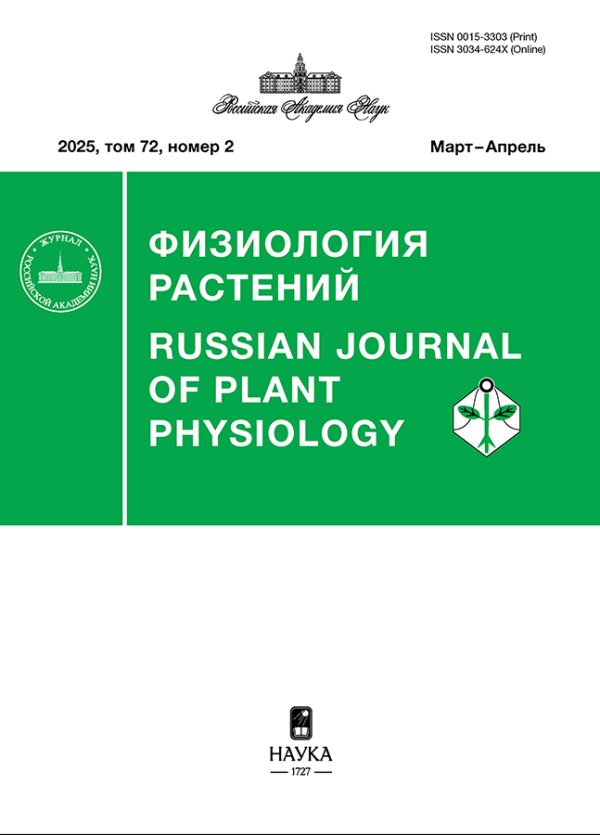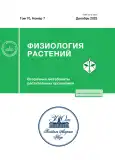HPLC-MS Analysis of Ginsenosides in Morphogenic Cell Cultures of Ginseng (Panax ginseng C.A. Meyer)
- Authors: Gorpenchenko T.Y.1, Grigorchuk V.P.1, Makhankov V.V.2, Kochkin D.V.3,4, Vologzhanina Y.V.1, Khandy M.T.1, Chernoded G.K.1, Zhuravlev Y.N.1
-
Affiliations:
- Federal Scientific Center of the East Asia Terrestrial Biodiversity, Far Eastern Branch, Russian Academy of Sciences
- Elyakov Pacific Institute of Bioorganic Chemistry, Far Eastern Branch, Russian Academy of Sciences
- Timiryazev Institute of Plant Physiology, Russian Academy of Sciences
- Moscow State University
- Issue: Vol 70, No 7 (2023)
- Pages: 823-835
- Section: ЭКСПЕРИМЕНТАЛЬНЫЕ СТАТЬИ
- URL: https://journals.rcsi.science/0015-3303/article/view/233788
- DOI: https://doi.org/10.31857/S0015330323601036
- EDN: https://elibrary.ru/ATLJPG
- ID: 233788
Cite item
Full Text
Abstract
The composition of triterpene glycosides in different in vitro tissues of cell lines (PgR–rhizogenic and PgG–hemogenic) and roots of ginseng plants (Panax ginseng C.A. Meyer), grown on plantations in Primorsky Krai (Russian Federation) was determined using the HPLC-MS method. More than 60 triterpene glycosides have been detected and characterized. The maximum content of ginsenosides was identified in the leaves of the hemogenic line. The total amount of ginsenosides in the PgG line embryonic tissue was lower compared to all other samples studied mainly due to the amount of protopanaxadiols. In all parts of the PgR line, the content of protopanaxatriol Re was two times higher than in the root of the intact plant. A high content of protopanaxatriols and oleanolic ginsenosides was found in the basal parts of PgR and PgG calli. Thus, morphogenic cell lines not only repeated the pattern of qualitative ginsenosides composition in comparison with individual parts of native roots and leaves but also demonstrated an increase in their diversity and quantity.
About the authors
T. Yu. Gorpenchenko
Federal Scientific Center of the East Asia Terrestrial Biodiversity, Far Eastern Branch, Russian Academy of Sciences
Email: gorpenchenko@biosoil.ru
Vladivostok, Russia
V. P. Grigorchuk
Federal Scientific Center of the East Asia Terrestrial Biodiversity, Far Eastern Branch, Russian Academy of Sciences
Email: gorpenchenko@biosoil.ru
Vladivostok, Russia
V. V. Makhankov
Elyakov Pacific Institute of Bioorganic Chemistry, Far Eastern Branch, Russian Academy of Sciences
Email: gorpenchenko@biosoil.ru
Vladivostok, Russia
D. V. Kochkin
Timiryazev Institute of Plant Physiology, Russian Academy of Sciences; Moscow State University
Email: gorpenchenko@biosoil.ru
Moscow, Russia; Moscow, Russia
Yu. V. Vologzhanina
Federal Scientific Center of the East Asia Terrestrial Biodiversity, Far Eastern Branch, Russian Academy of Sciences
Email: gorpenchenko@biosoil.ru
Vladivostok, Russia
M. T. Khandy
Federal Scientific Center of the East Asia Terrestrial Biodiversity, Far Eastern Branch, Russian Academy of Sciences
Email: gorpenchenko@biosoil.ru
Vladivostok, Russia
G. K. Chernoded
Federal Scientific Center of the East Asia Terrestrial Biodiversity, Far Eastern Branch, Russian Academy of Sciences
Email: gorpenchenko@biosoil.ru
Vladivostok, Russia
Yu. N. Zhuravlev
Federal Scientific Center of the East Asia Terrestrial Biodiversity, Far Eastern Branch, Russian Academy of Sciences
Author for correspondence.
Email: gorpenchenko@biosoil.ru
Vladivostok, Russia
References
- Журавлев Ю.Н., Томских А.А., Горпенченко Т.Ю. История и перспективы генетических исследований женьшеня на Дальнем Востоке России // Вестник ДВО РАН. 2022. № 4. С. 101. https://doi.org/10.37102/0869-7698_2022_224_04_9
- Chen W., Balan P., Popovich B.G. Ginsenosides analysis of New Zealand-grown forest Panax ginseng by LC-QTOF-MS/MS // J. Ginseng Res. 2020. V. 44. P. 552. https://doi.org/10.1016/j.jgr.2019.04.007
- Yang Y., Ju Z., Yang Y., Zhang Y., Yang L., Wang Z. Phytochemical analysis of Panax species: a review // J. Ginseng Res. 2021. V. 45. P. 1. https://doi.org/10.1016/j.jgr.2019.12.009
- Du Z., Li J., Zhang X., Pei J., Huang L. An integrated LC-MS-based strategy for the quality assessment and discrimination of three Panax species // Molecules. 2018. V. 23. P. 2988. https://doi.org/10.3390/molecules23112988
- Li F., Lv C., Li Q., Wang J., Song D., Liu P., Zhang D., Lu J. Chemical and bioactive comparison of flowers of Panax ginseng Meyer, Panax quinquefolius L., and Panax notoginseng Burk // J. Ginseng Res. 2017. V. 41. P. 487. https://doi.org/10.1016/jjgr.2016.08.008
- Lee J.W., Choi B.-R., Kim Y.-C., Choi D.J., Lee Y.-S., Kim G.-S., Baek N.-I., Kim S.-Y., Lee D.Y. Comprehensive profiling and quantification of ginsenosides in the root, stem, leaf, and berry of Panax ginseng by UPLC-QTOF/MS // Molecules. 2017. V. 22 P. 2147. https://doi.org/10.3390/molecules22122147
- Lee J., Han H., Yuan X., Park E., Lee J., Kim J.H. A rapid, simultaneous and quantitative analysis of 26 ginsenosides in white and red Panax ginseng using LC-M-S/MS // Appl. Biol. Chem. 2021. V. 64:13. https://doi.org/10.1186/s13765-020-00588-w
- Di P., Yan Y., Wang P., Yan M., Wang Y.-P., Huang L.-Q. Integrative SMRT sequencing and ginsenoside profiling analysis provide insights into the biosynthesis of ginsenoside in Panax quinquefolium // Chin. J. Nat. Med. 2022. V. 20. P. 614. https://doi.org/10.1016/S1875-5364(22)60198-5
- Gantait S., Mitra M., Chen J.-T. Biotechnological interventions for ginsenosides production // Biomolecules. 2020. V. 10. P. 538. https://doi.org/10.3390/biom10040538
- Xu F., Valappil A.K., Mathiyalagan R., Tran T.N.A., Ramadhania Z.M., Awais M., Yang D.C. In vitro cultivation and ginsenosides accumulation in Panax ginseng: a review // Plants. 2023. V. 12. P. 3165. https://doi.org/10.3390/ plants12173165
- Nosov A.M., Popova E.V., Kochkin D.V. Isoprenoid production via plant cell cultures: biosynthesis, accumulation and scaling-up to bioreactors // Production of biomass and bioactive compounds using bioreactor technology / Ed. Paek K.Y., Murthy H., Zhong J.J. Dordrecht: Springer-Verlag. 2014. P. 563. https://doi.org/10.1007/978-94-017-9223-3_23
- Atanasov A.G., Waltenberger B., Pferschy-Wenzig E.M., Linder T., Wawrosch C., Uhrin P., Stuppner H. Discovery and resupply of pharmacologically active plant-derived natural products: a review // Biotechnol. Adv. 2015. V. 33. P. 1582. https://doi.org/10.1016/j.biotechadv.2015.08.001
- Nakonechnaya O.V., Gafitskaya I.V., Grigorchuk V.P., Gorpenchenko T.Y., Bezdelev A.B., Zhuravlev Y.N. Polyphenol composition of Dracocephalum charkeviczii Prob. plants in in situ and in vitro conditions // Russ. J. Plant Physiol. 2022. V. 69:27. https://doi.org/10.1134/S1021443722010149
- Kochkin D.V., Galishev B.A., Glagoleva E.S., Titova M.V., Nosov A.M. Rare triterpene glycoside of ginseng (ginsenoside malonyl-Rg 1) detected in plant cell suspension culture of Panax japonicus var. repens // Russ. J. Plant Physiol. 2017. V. 64. P. 649. https://doi.org/10.1134/S102144371705003X
- Glagoleva E.S., Konstantinova S.V., Kochkin D.V., Ossipov V., Titova M.V., Popova E.V., Nosov A.M., Paek K.Y. Predominance of oleanane-type ginsenoside R0 and malonyl esters of protopanaxadiol-type ginsenosides in the 20-year-old suspension cell culture of Panax japonicus C.A. Meyer // Ind. Crops Prod. 2022. V. 177 P. 552114417 https://doi.org/10.1016/j.indcrop.2021.114417
- Wu J., Zhong J.-J. Production of ginseng and its bioactive components in plant cell culture: Current technological and applied aspects // J. Biotechnol. 1999. V. 68. P. 89. https://doi.org/10.1016/s0168-1656(98)00195-3
- Kochkin D.V., Glagoleva E.S., Galischev B.A., Spiridovich E.V., Nosov A.M., Reshetnikov V.N. Analysis of gynzenosides in the roots of Panax ginseng introduced in the central botanical garden of NAS of Belarus // Doklady of the National Academy of Sciences of Belarus. 2018. V. 62. P. 447. https://doi.org/10.29235/1561-8323-2018-62-4-447-454
- Балеев Д.Н., Осипов В.И., Савин П.С., Байкова Ю.П., Сидельников Н.И. Сравнительный анализ состава и содержания гинзенозидов в каллусной культуре клеток и корне женьшеня обыкновенного, Panax ginseng // Биотехнология. 2022. Т. 38. № 2. С. 57. https://doi.org/10.56304/S0234275822020028
- Song X., Wu H., Piao X., Yin Z., Yin Ch. Microbial transformation of ginsenosides extracted from Panax ginseng adventitious roots in an airlift bioreactor // Electron. J. Biotechnol. 2017. V. 26. P. 20. https://doi.org/10.1016/j.ejbt.2016.12.005
- Журавлев Ю.Н., Гетманова Е.С., Музарок Т.И., Булгаков В.П. Способ микроразмножения женьшеня. Патент SU1824114A1, 1993.
- Murashige T., Skoog F. A revised medium for rapid growth and bioassays with Tobacco tissue cultures // Physiol. Plant. 1962. V. 15. P. 473. https://doi.org/10.1111/j.1399-3054.1962.tb08052.x
- Жинкина Н.А., Воронова О.Н. К методике окраски эмбриологических препаратов // Ботанический журнал. 2000. Т. 85. С. 168.
- Gorpenchenko T.Y., Kiselev K.V., Bulgakov V.P., Tchernoded G.K., Bragina E.A., Khodakovskaya M.V., Koren O.G., Batygina T.B., Zhuravlev Y.N. The Agrobacterium rhizogenes rolC-gene-induced somatic embryogenesis and shoot organogenesis in Panax ginseng transformed calluses // Planta. 2006. V. 223. P. 457. https://doi.org/10.1007/s00425-005-0102-2
- Уварова Н.И., Маханьков В.В., Малиновская Г.В., Самошина Н.Ф., Атопкина Л.Н., Лихацкая Г.Н., Ким Н.Ю., Анисимов М.М., Еляков Г.Б. Химическая характеристика, сравнительное количественное определение и биологическая активность тритерпеновых гликозидов из дикого и плантационного женьшеня Panax ginseng C.A. Meyer, произрастающих в Приморском крае // Химико-фармацевтический журнал. 2000. Т. 34. С. 19.
- Маханьков В.В., Бурундукова О.Л., Музарок Т.И., Уварова Н.И., Журавлев Ю.Н. Содержание гинзенозидов в листьях Panax ginseng C.A. Meyer в зависимости от возраста и условий произрастания // Растительные ресурсы. 2007. Т. 3. С. 107.
- Chen Y., Zhao Z., Chen H., Yi T., Qin M., Liang Z. Chemical differentiation and quality evaluation of commercial asian and american ginsengs based on a UHPLC–QTOF/MS/MS metabolomics approach // Phytochem. Anal. 2015. V. 26 P. 145. https://doi.org/10.1002/pca.2546
- Qiu S., Yang W.Z., Shi X.J., Yao C.L., Yang M., Liu X., Jiang B.-H., Wu W.-Y., Guo D.A. A green protocol for efficient discovery of novel natural compounds: characterization of new ginsenosides from the stems and leaves of Panax ginseng as a case study // Anal. Chim. Acta. 2015. V. 893 P. 65. https://doi.org/10.1016/j.aca.2015.08.048
- Wang H.P., Zhang Y.B., Yang X.W., Zhao D.Q., Wang Y.P. Rapid characterization of ginsenosides in the roots and rhizomes of Panax ginseng by UPLC-DAD-QTOF-MS/MS and simultaneous determination of 19 ginsenosides by HPLC-ESI-MS // J. Ginseng Res. 2016. V. 40 P. 382. https://doi.org/10.1016/j.jgr.2015.12.001
- Minh Duc N., Thoi Nham N., Kasai R., Ito A., Yamasaki K., Tanaka O. Saponins from Vietnamese ginseng, Panax vietnamensis HA et GRUSHV. Collected in Central Vietnam. I. // Chem. Pharm. Bull. 1993. V. 41. P. 2010. https://doi.org/10.1248/cpb.41.2010
- Dictionary of food compounds additives, flavors, and ingredient / Ed. Sh. Yannai. 2004. A CRC ress Company Boca Raton, London, New York, Washington, D.C. 1782 p.
- Van Le T.H., Lee G.J., Vu H.K.L., Kwon S.W., Nguyen N.K., Park J.H., Nguyen M.D. Ginseng saponins in different parts of Panax vietnamensis // Chem. Pharm. Bull. 2015. V. 63 P. 950. https://doi.org/10.1248/cpb.c15-00369
- Peng M., Zhang T., Ding Y., Yi Y., Yang Y., Le J. Structure-based prediction of CAD response factors 1 of dammarane-type tetracyclic triterpenoid saponins and its application to the analysis of saponin contents in raw and processed Panax notoginseng // RSC Adv. 2016. V. 6. P. 36987. https://doi.org/10.1039/C6RA03193E
- Wang H.-P., Wang Z.-J., Du J., Lin Z.-Z., Zhao C., Zhang R., Yin Q., Fan C.-L., Peng P., Wang Z.-B. Comprehensive identification of ginsenosides in the roots and rhizomes of Panax ginseng based on their molecular features-oriented precursor ions selection and targeted MS/MS analysis // Molecules. 2023. V. 28. P. 941. https://doi.org/10.3390/molecules28030941
- Oh J.Y., Kim Y.J., Jang M.G., Joo S.C., Kwon W.S., Kim S.Y., Jung S.-K., Yang D.C. Investigation of ginsenosides in different tissues after elicitor treatment in Panax ginseng // J. Ginseng Res. 2014. V. 38. P. 270. https://doi.org/10.1016/j.jgr.2014.04.004
- Rahimi S., Kim Y.J., Yang D.C. Production of ginseng saponins: elicitation strategy and signal transductions // Appl. Microbiol. Biotechnol. 2015. V. 99. P. 6987.
- Chopra P., Chhillar H., Kim Y.J., Jo I.H., Kim S.T., Gupta R. Phytochemistry of ginsenosides: recent advancements and emerging roles // Crit. Rev. Food Sci. Nutr. 2023. V. 63. P. 613. https://doi.org/10.1080/10408398.2021.1952159
- Moses T., Papadopoulou K.K., Osbourn A. Metabolic and functional diversity of saponins, biosynthetic intermediates and semi-synthetic derivatives // Crit. Rev. Biochem. Mol. Biol. 2014. V. 40. P. 439. https://doi.org/10.3109/10409238.2014.953628
- Fehér A. Callus, dedifferentiation, totipotency, somatic embryogenesis: what these terms mean in the era of molecular plant biology? // Front. Plant Sci. 2019. V. 10: 536. https://doi.org/10.3389/fpls.2019.00536
- Yang Y., Ju Z., Yang Y., Zhang Y., Yang L., Wang Z. Phytochemical analysis of Panax species: a review // J. Ginseng Res. 2021. V. 45. P. 1. https://doi.org/10.1016/j.jgr.2019.12.009
- Yao C.L., Pan H.Q., Wang H., Yao S., Yang W.Z., Hou J.J., Jin Q.H., Wu W.Y., Guo D.A. Global profiling combined with predicted metabolites screening for discovery of natural compounds: characterization of ginsenosides in the leaves of Panax notoginseng as a case study // J. Chromatogr. 2018. V. 1538. P. 34. https://doi.org/10.1016/j.chroma.2018.01.040
Supplementary files














